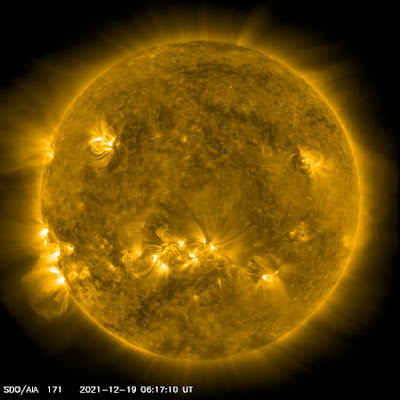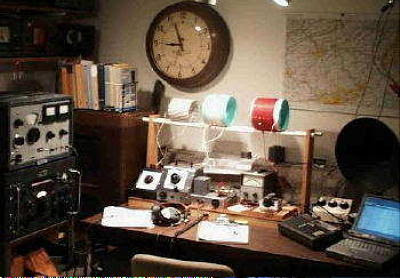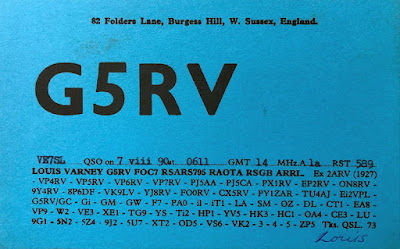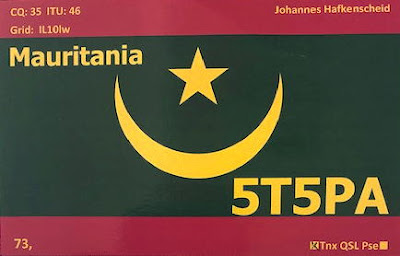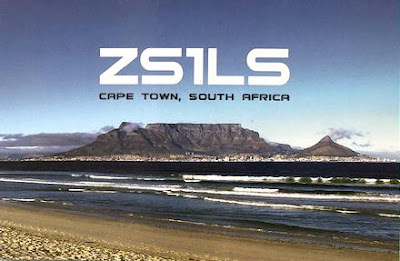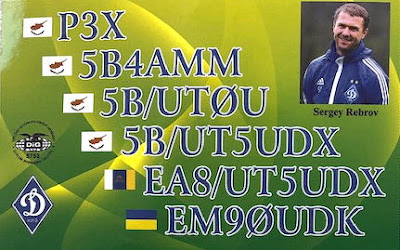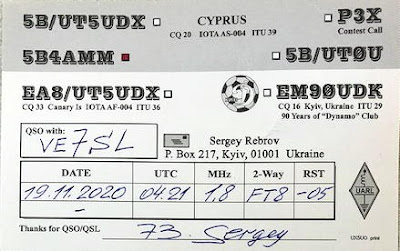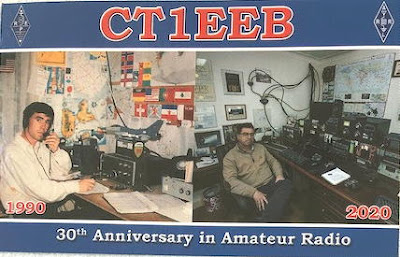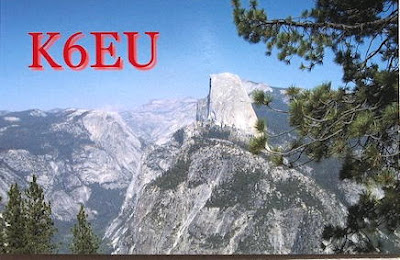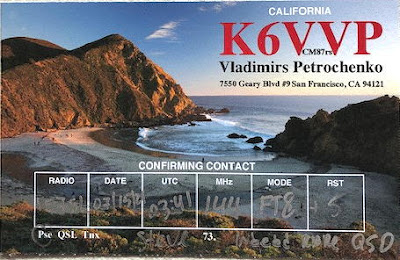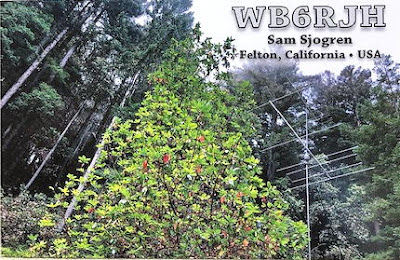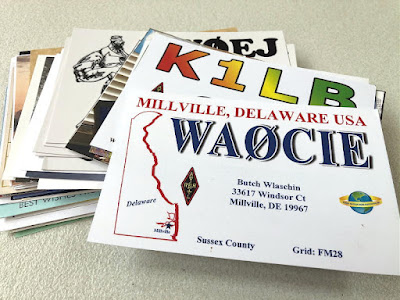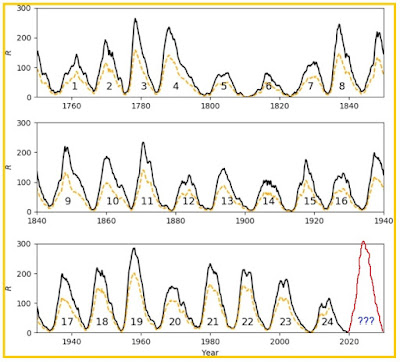Author Archive
 Cycle 25 … On The Move?
Cycle 25 … On The Move?
Anyone looking at the Sun this week has to be impressed with its sudden reawakening over the past few days. From its recent somewhat troubling slumber, with flux numbers in the high 70s, these values have quickly risen to a Cycle 25 high in the 120s as of early Saturday. With at least two more active regions about to rotate into view shortly, it seems as though these numbers might continue to grow.
What is interesting is the suddenness with which these groups formed as this is a keystone marker for the long awaited ‘terminator’ event … the point at which cycle growth starts to increase rapidly. Is this it or will the Sun go back to sleep as it has in the past few excursions into the 90’s?
If this rapid increase does indeed herald the terminator's arrival, it’s a sign that Cycle 25 should be one of above average strength. Wouldn’t that be nice after Cycle 24’s weak showing over the past 11 years.
With the present asymmetry of the Sun's two hemisphere, we are guaranteed a cycle with a double hump in the peak years. The first peak is usually the strongest but not always. Let's see how Cycle 25 plays out in this department.
I’ve yet to do any comparisons with past progress of strong cycles at this same point into their upward climb but let’s cross our fingers and hope the present numbers continue for some time. There will always be drops of course but if recovery is quick, we may still be in for a good ride in Cycle 25.
 Hunting For NDBs In CLE 274
Hunting For NDBs In CLE 274
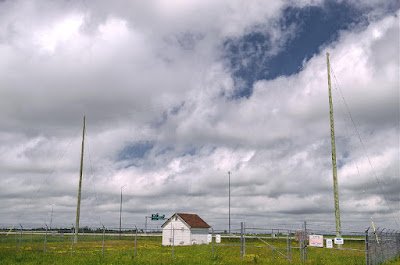 |
| ZWG - 287kHz Winnipeg courtesy: http://www.ve3gop.com/ |
I know it's hard to believe but it's CLE time once again. How quickly time zooms by.
When tuning for NDBs, put your receiver in the CW mode and listen for the NDB's CW identifier, repeated every few seconds. Listen for U.S. NDB identifiers approximately 1 kHz higher or lower than the published transmitted frequency since these beacons are modulated with a 1020 Hz tone approximately.
For example, 'AA' near Fargo, ND, transmitted on 365 kHz and its upper sideband CW identifier was tuned at 366.025 kHz while its lower sideband CW ident could be tuned at 363.946 kHz. Its USB tone was actually 1025 Hz while its LSB tone was 1054 Hz.
Often, one sideband will be much stronger than the other so if you don't hear the first one, try listening on the other sideband.
Canadian NDBs normally have an USB tone only, usually very close to 400 Hz. They also have a long dash (keydown) following the CW identifier.
All NDBs heard in North America will be listed in the RNA database (updated daily) while those heard in Europe may be found in the REU database. Beacons heard outside of these regions will be found in the RWW database. These databases have recently been re-vamped and are slicker than ever before!
From CLE organizers comes the following CLE info:
Hello all
Here are brief details for our 274th co-ordinated listening event next weekend.
It spans a 50 kHz frequency range - about three times wider than usual.
In that range, the Rxx database is showing about 200 active NDBs located in Europe, 120 in North America, 35 in Oceania. The numbers are approximately doubled if you include DX from other parts of the World that have been heard from each of those three regions.
Days: Friday 26 November – Monday 29 November
Times: Start and end at midday, your LOCAL time
Range: 270.0 - 319.9 kHz (NDB signals only)
Part of the frequency range also has DGPS signals among the NDBs.
We last listened on these frequencies in CLE259 in August 2020.
Any first-time CLE logs will be very welcome, as always.
Send your final log to the List (not in an attachment, please) with 'CLE274’ and ‘FINAL' in its title (important).
Show on each line:
# The Date (e.g. '2021-11-26', etc., or just '26' )
# The Time in UTC (the day changes at 00:00 UTC).
# kHz - the nominal published frequency, if known.
# The Call Ident.
Please show those main items FIRST. Other optional details such as Location and Distance go LATER in the same line.
As always, of course, tell us your own location and give brief details of the equipment that you were using during the Event.
We will send the usual 'Any More Logs?' email at about 19:00 UTC on Tuesday so you can check that your log has been found OK.
Do make sure that your log has arrived on the List by 08:00 UTC on Wednesday 01 December at the very latest.
We hope to complete making the combined results within a day or two.
You can soon find full details about current and past CLEs from the CLE page http://www.ndblist.info/cle.htm It includes access to the CLE274 seeklists for your part of the World, prepared from all the previous loggings in Rxx.
Good listening
- enjoy the CLE.
Brian and Joachim
------------------------------------------------------------------
From: Brian Keyte G3SIA ndbcle'at'gmail.com
Location: Surrey, SE England (CLE coordinator)
------------------------------------------------------------------
(If you would like to listen remotely you could use any one remote receiver for your loggings, stating its location and owner and with their permission if required. A remote listener may NOT also use
another receiver, local or remote, to make further loggings for the same CLE)
These listening events serve several purposes. They
• determine, worldwide, which beacons are out-of-service or have gone silent since the last CLE covering this range
• will indicate the state of propagation conditions at the various participant locations
• will give you an indication of how well your LF/MF receiving system is working
• give participants a fun yet challenging activity to keep their listening skills honed
Final details can be found at the NDB List website, and worldwide results, for every participant, will be posted there a few days after the event.
The NDB List Group is a great place to learn more about the 'Art of NDB DXing' or to meet other DXers in your region. There is a lot of good information available there and new members are always very welcome. As well, you can follow the results of other CLE participants from night to night as propagation is always an active topic of discussion.
You need not be an NDB List member to participate in the CLEs and all reports, no matter how small, are of much value to the organizers.
Remember - 'First-time' logs are always VERY welcome!
Reports may be sent to the NDB List Group or e-mailed to CLE co-ordinator, Brian Keyte (G3SIA), whose address appears above. If you are a member of the group, all final results will also be e-mailed and posted there.
Please ... give the CLE a try ... then let us know what NDB's can be heard from your location! Your report can then be added to the worldwide database to help keep it up-to-date.
Have fun and good hunting!
 The Crystal Radio DX Contest
The Crystal Radio DX Contest
I first became intrigued with Crystal Radio DXing several years ago when I happened across the above image showing the Crystal Radio DX Contest setup of Al Klase, N3FRQ. I was immediately surprised to learn that 'DX' could actually be heard on a crystal radio ... I could never hear anything but two strong locals on my own crystal set as a kid. I also knew immediately that I wanted to learn more and hopefully get into the next Crystal Radio DX Contest!
Back then, the contest was organized by the Yahoo Crystal Radio Group and then later, by the Alabama Crystal Radio Group. These contests were exceptionally popular and always sparked a huge amount of discussion, spurred new construction and seemed to create a lot of ‘crystal radio’ excitement in the months leading up to the contest.
Crystal radios can be as simple as a 'single-tuned' set like this, built by Mike Simpson from plans shown in Alfred P. Morgan's "The Boys' Third Book of Radio and Electronics". Read the nice back-story from Mike about this project! In the right location and with a good antenna, even simple sets like this are capable of hearing skywave signals.
| (courtesy Mike Simpson http://www.analogdial.com) |
At the other end of the spectrum are elaborate DX sets like this one, built by Mike Tuggle in Hawaii.
| Mike Tuggle's 'Lyonodyne' DX set | |
Mike regularly hears AM broadcast band stations in Canada and the USA on his crystal radio from his location in Hawaii ... he explains the details here.
Recently, along with Doug (K4LY) and Dave (N1DAY), I discussed how we might be able to again resurrect this popular contest activity and after countless e-mail exchanges, we’ve now put together just such an event!
Accordingly, we invite any and all crystal radio builders and users to participate in the upcoming Crystal Radio DX Contest to be held from January 1 through January 8th, 2022!
This date period should provide ample time for new construction to take place or to make improvements to present radios, while hopefully finding some nice mid-winter propagation on the broadcast band … half the battle when it comes to DXing with crystal radios.
Some ideas have been gleaned from previous contests to provide a minimum set of simple rules that will hopefully accommodate crystal radios of all types.
There are two entry classes, ‘OPEN’ and ‘HOBBY’ with guidelines for each. You will only be competing against others in the same category or maybe only against yourself if trying to reach a set goal.
In the true spirit of previous contests, it’s more about having fun, optimizing your passive receiving system and creating some great discussions, both before and after the contest … this really makes every participant a winner in the end.
As an anchor point for discussions regarding this and future such events, the Facebook ‘Crystal Radio DX Contest Group’ has been created and anyone that might be curious or interested in possible contest participation is encouraged to join.
In no way is this group intended to usurp activity from any present groups and it should not. It will be a focal point where members can find and discuss activities generated by the upcoming event. What are you building or improving for the contest? What are your plans? Share your crystal radio DXing strategies. Any thoughts or comments related to the upcoming event are fair game!
The Crystal Radio DX Contest Group can be found here where you can find discussion as well as the rules.
As well, the rules in pdf form, may be found here if you are not on Facebook.
Hopefully you will consider entering the contest ... it was always an enjoyable event.
 Hunting For NDBs In CLE273
Hunting For NDBs In CLE273
 |
| BK-224 Baker Lake, NU ( http://www.ve3gop.com) |
BK has gobs of power and a big antenna ... see if you hear it!
When tuning for NDBs, put your receiver in the CW mode and listen for the NDB's CW identifier, repeated every few seconds. Listen for U.S. NDB identifiers approximately 1 kHz higher or lower than the published transmitted frequency since these beacons are modulated with a 1020 Hz tone approximately.
For example, 'AA' near Fargo, ND, transmitted on 365 kHz and its upper sideband CW identifier was tuned at 366.025 kHz while its lower sideband CW ident could be tuned at 363.946 kHz. Its USB tone was actually 1025 Hz while its LSB tone was 1054 Hz.
Often, one sideband will be much stronger than the other so if you don't hear the first one, try listening on the other sideband.
Canadian NDBs normally have an USB tone only, usually very close to 400 Hz. They also have a long dash (keydown) following the CW identifier.
All NDBs heard in North America will be listed in the RNA database (updated daily) while those heard in Europe may be found in the REU database. Beacons heard outside of these regions will be found in the RWW database. These databases have recently been re-vamped and are slicker than ever before!
From CLE organizers comes the following CLE info:
Hello all,
Here are brief details of our 273rd co-ordinated listening event, less than a week away. Ideal to try out a CLE for the first time?
Days: Friday 22nd - Monday 25th Oct., Midday-Midday, your local time
- NDBs from 190 - 239.9 kHz
- PLUS: Normal NDBs with carriers on the 'half-way' frequencies nnn.5 kHz from 190.5 - 999.5 kHz
So, unusually, it is a CLE in two parts. The first part is hunting for the NDBs whose published frequencies are lower than 240 kHz.
The second part is hunting for the NDBs whose carrier frequencies are 'half-way'. E.g. 267.5 OPW, 333.5 VOG, 370.5 LB, 381.5 SJX (in Ml), 390.5 ITR, 427.5 OB (in AFS), 433.5 HEN and 514.5 LA
Most Europe listeners will hear few or none from part 1, while listeners away from Europe will hear few or none from part 2.
The last time we covered these frequencies was for CLE257 in June 2020.
Please log all the NDBs (within the frequency ranges specified) that you can identify plus any UNIDs that you come across there.
Send your final log to the List (not in an attachment, please) with 'CLE273’ and ‘FINAL' in its title (important).
Show on each line:
# The Date (e.g. '2021-10-23', etc., or just '24' )
# The Time in UTC (the day changes at 00:00 UTC).
# kHz - the nominal published frequency, if known.
# The Call Ident.
Please show those main items FIRST. Other optional details such as Location and Distance go LATER in the same line.
As always, of course, tell us your own location and give brief details of the equipment that you were using during the Event.
We will send the usual 'Any More Logs?' email at about 19:00 UTC on Tuesday so you can check that your log has been found OK.
Do make sure that your log has arrived on the List by 08:00 UTC on Wednesday 27 October at the very latest.
We hope to complete making the combined results within a day or two.
You can soon find full details about current and past CLEs from the CLE page http://www.ndblist.info/cle.htm It includes access to the CLE273 seeklists for your part of the World, prepared from all the previous loggings in Rxx.
Good listening
- enjoy the CLE.
Brian and Joachim
------------------------------------------------------------------
From: Brian Keyte G3SIA ndbcle'at'gmail.com
Location: Surrey, SE England (CLE coordinator)
------------------------------------------------------------------
(If you would like to listen remotely you could use any one remote
receiver for your loggings, stating its location and owner and with
their permission if required. A remote listener may NOT also use
another receiver, local or remote, to make further loggings for the
same CLE)
These listening events serve several purposes. They
• determine, worldwide, which beacons are out-of-service or have gone silent since the last CLE covering this range
• will indicate the state of propagation conditions at the various participant locations
• will give you an indication of how well your LF/MF receiving system is working
• give participants a fun yet challenging activity to keep their listening skills honed
Final details can be found at the NDB List website, and worldwide results, for every participant, will be posted there a few days after the event.
The NDB List Group is a great place to learn more about the 'Art of NDB DXing' or to meet other DXers in your region. There is a lot of good information available there and new members are always very welcome. As well, you can follow the results of other CLE participants from night to night as propagation is always an active topic of discussion.
You need not be an NDB List member to participate in the CLEs and all reports, no matter how small, are of much value to the organizers.
Remember - 'First-time' logs are always VERY welcome!
Reports may be sent to the NDB List Group or e-mailed to CLE co-ordinator, Brian Keyte (G3SIA), whose address appears above. If you are a member of the group, all final results will also be e-mailed and posted there.
Please ... give the CLE a try ... then let us know what NDB's can be heard from your location! Your report can then be added to the worldwide database to help keep it up-to-date.
Have fun and good hunting!
 My Summer QSL Mailbox
My Summer QSL Mailbox
Most of my blog readers know how much I love QSLs ... real paper ones that is. In fact the lure of collecting cards was one of the main things that hooked me on radio as a pre-teen SWL!
All of the important QSLs from last winter’s 160m DX season have finally arrived along with cards for the new ones worked during this summer’s Sporadic E season on 6m … plus some other cards of interest.
Both seasons provided some good DX opportunities and several new DXCC entities were added to my totals. In fact the new countries worked this summer on the magic band finally gave me 100 confirmed for DXCC after being on the band since Cycle 20! This summer was probably the best I’ve ever seen in terms of long haul propagation to Europe and Japan. Sadly almost all of the activity is on FT8 even though signals were usually more than strong enough for CW (and sometimes SSB) modes. Hopefully the band will once again see more of these traditional modes as the solar cycle progresses.
The Top Band season was highlighted with a nice three-week period of exceptionally good propagation to many parts of Europe and regions beyond. Four new DXCC countries were added to my total bringing my 160m DXCC to 163 confirmed.
Some additional 630m band wallpaper also arrived over the summer from Arliss, W7XU. In mid-April, well-past the prime DX season, he ventured from his normal QTH in South Dakota to become W7XU/5 in Louisiana. I never in the world expected to even hear his small portable campground station let alone work him, but his signal was truly outstanding and we worked very quickly. Arliss gave me state #38 on 630m. We worked each other a few months later but this time on 2m during the August Perseids meteor shower when he was back at home in South Dakota.
The evening of July 15th produced a rarity for VE7 land … a short Sporadic E opening to California on 2m.
Four stations in and around the San Francisco region were worked with several of the signals being exceptionally strong, often the case on 2m Es.
And lastly, all 50 cards for last winter’s 40m Worked All States project were gathered over the summer months. All contacts were made using my homebrewed 1-tube Neophyte regen along with its matching 1-tube crystal oscillator.
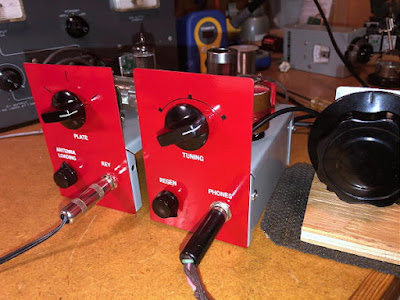 |
| Neophyte Twins with outboard bandspread on the regen |
I’ve now parked the pair on 3560 for the winter while I attempt to repeat the challenge of working and confirming all 50 states. With 7 so far, I’m looking for 43 more! If you can help out with a listen (I’m on most evenings) or with a sked, I’d love to work you on 80m with the 1-tubers.
Did I mention that I really love QSLs?
 Hunting For NDBs In CLE272
Hunting For NDBs In CLE272
 |
| ML - 392 Charlevoix, Quebec |
It's CLE time! 'CLE's are 'Co-ordinated Listening Events, and NDB DXers around the world focus their listening time on one small slice of the NDB spectrum.
A 'challenge target' for listeners in North America is ML - 392kHz in Charlevoix, Quebec. Listen for ML's upper sideband on 392.404kHz. ML is widely heard in Europe and throughout North America. Its 500W and big tower work well!
When tuning for NDBs, put your receiver in the CW mode and listen for the NDB's CW identifier, repeated every few seconds. Listen for U.S. NDB identifiers approximately 1 kHz higher or lower than the published transmitted frequency since these beacons are modulated with a 1020 Hz tone approximately.
For example, 'AA' near Fargo, ND, transmitted on 365 kHz and its upper sideband CW identifier was tuned at 366.025 kHz while its lower sideband CW ident could be tuned at 363.946 kHz. Its USB tone was actually 1025 Hz while its LSB tone was 1054 Hz.
Often, one sideband will be much stronger than the other so if you don't hear the first one, try listening on the other sideband.
Canadian NDBs normally have an USB tone only, usually very close to 400 Hz. They also have a long dash (keydown) following the CW identifier.
All NDBs heard in North America will be listed in the RNA database (updated daily) while those heard in Europe may be found in the REU database. Beacons heard outside of these regions will be found in the RWW database. These databases have recently been re-vamped and are slicker than ever before!
From CLE organizers comes the following CLE info:
Hello all,
Have you tried one of our Co-ordinated Listening Events yet?
Whether short logs or long ones, making them is enjoyed by beginners and experts alike - and reading them is enjoyed by all.
Our 272nd Coordinated Listening Event starts this Friday. This 15 kHz frequency range is quite a busy one, even the Pacific region (Oceania) having several NDBs to be found.
Days: Friday 24 Sept. - Monday 27 Sept. 2021
Times: Start and end at midday your LOCAL time
Range: 385 - 399.9 kHz
Please log all the NDBs that you can identify with nominal (listed) frequencies in the range - it includes 385 kHz, but not 400 kHz - plus any UNIDs that you come across there.
Send your final log to the List (not in an attachment, please) with 'CLE272’ and ‘FINAL' in its title (important).
Show on each line:
# The Date (e.g. '2021-09-24', etc., or just '24' )
# The Time in UTC (the day changes at 00:00 UTC).
# kHz - the nominal published frequency, if known.
# The Call Ident.
Please show those main items FIRST. Other optional details such as Location and Distance go LATER in the same line.
As always, of course, tell us your own location and give brief details of the equipment that you were using during the Event.
We will send the usual 'Any More Logs?' email at about 19:00 UTC on Tuesday so you can check that your log has been found OK.
Do make sure that your log has arrived on the List by 08:00 UTC on Wednesday 29 Sept. at the very latest.
We hope to complete making the combined results within a day or two.
You can find full details about current and past CLEs from the CLE page http://www.ndblist.info/cle.htm It includes access to the CLE272 seeklists for your part of the World, prepared from all the previous loggings in Rxx.
Good listening
- enjoy the CLE.
Brian and Joachim
------------------------------------------------------------------
From: Brian Keyte G3SIA ndbcle'at'gmail.com
Location: Surrey, SE England (CLE coordinator)
------------------------------------------------------------------
(If you would like to listen remotely you could use any one remote
receiver for your loggings, stating its location and owner and with
their permission if required. A remote listener may NOT also use
another receiver, local or remote, to make further loggings for the
same CLE)
These listening events serve several purposes. They
• determine, worldwide, which beacons are out-of-service or have gone silent since the last CLE covering this range
• will indicate the state of propagation conditions at the various participant locations
• will give you an indication of how well your LF/MF receiving system is working
• give participants a fun yet challenging activity to keep their listening skills honed
Final details can be found at the NDB List website, and worldwide results, for every participant, will be posted there a few days after the event.
The NDB List Group is a great place to learn more about the 'Art of NDB DXing' or to meet other DXers in your region. There is a lot of good information available there and new members are always very welcome. As well, you can follow the results of other CLE participants from night to night as propagation is always an active topic of discussion.
You need not be an NDB List member to participate in the CLEs and all reports, no matter how small, are of much value to the organizers.
Remember - 'First-time' logs are always VERY welcome!
Reports may be sent to the NDB List Group or e-mailed to CLE co-ordinator, Brian Keyte (G3SIA), whose address appears above. If you are a member of the group, all final results will also be e-mailed and posted there.
Please ... give the CLE a try ... then let us know what NDB's can be heard from your location! Your report can then be added to the worldwide database to help keep it up-to-date.
Have fun and good hunting!
 Solar Cycle 25 – Where Are We Headed?
Solar Cycle 25 – Where Are We Headed?
This coming week might be a significant one for the progress of Solar Cycle 25. Going forward, the next two months should give us a good indication of just exactly where our latest cycle is heading.
Cycle 25 is now in its 21st month, having started in November 2019.
One way to gauge the growth of a cycle is by observing the radio energy it emits at 2800MHz (10.7cm).
This ‘solar flux’ value changes from day to day and from hour to hour, depending mainly on the number of sunspots and their level of activity.
The 2800MHz real-time solar flux units are published three times per day, after being measured at the Dominion Radio Astrophysical Observatory in Penticton, British Columbia. The ‘observed values’ are the actual measured levels while the ‘adjusted values’ reflect compensations for things such as the Sun-Earth distance, background sky noise, solar bursts, atmospheric absorption etc. Of the two values, the ‘adjusted value’ is more descriptive of the Sun’s true behaviour.
Although far from definitive, comparisons with previous cycles may shed some light on Cycle 25’s future. We should remember that almost all predictions from various solar physicists called for another very weak cycle, some saying even weaker than Cycle 24, the poorest in the past 100 years. Of the many predictions, one that varied substantially from the pack was one from Dr. Scott McIntosh’s team.
Their paper called for a very strong cycle, possibly the strongest one ever. We should know shortly which path our latest cycle will favor.
Let’s compare some of the things now known for sure about Cycle 25 with Cycle 19 (strongest ever recorded), Cycles 21, 22 and 23 (all strong, above average cycles that produced several winters of exciting 6m F2 propagation) and the recently-completed Cycle 24 (weakest in past 100 years).
A good indicator of a cycle’s possible future strength is the time that it takes to ramp-up and to really start building. Usually weaker cycles take much longer to do this so one way of looking at Cycle 25’s future might be to see how long it took each of these cycles to reach an adjusted solar flux value of 100.
Strong cycles are usually fast risers once growth is triggered. Most cycles start with flux values in the 60s and dither around for months or years with short surges into the 80s and 90s before dropping back again. A flux of 100 seems significant when looking at previous cycles as it is often the level where steady upward growth really begins, with fewer surges to a lower level.
Cycle 19
The ‘grandaddy’ of them all. It began in April ‘54 and eventually peaked with a SSN (Smoothed Sunspot Number) of 285. The highest solar flux reached was 345. Cycle 19 took 14 months to hit a solar flux of 100, then dropped back to the 80s for several weeks before ramping up once again. This time it just kept growing. Both hemispheres of the Sun were at similar levels of activity resulting in a cycle with a very strong single peak.
Cycle 21
Another strong cycle following a weak Cycle 20. It peaked with a SSN of 233 and produced a high flux level of 365.
Cycle 21 took 16 months to reach a solar flux of 100, dropping down to 70s and 80s for three months before taking off.
Cycle 22
A robust cycle as well with a SSN of 213 and a peak flux of 335. Cycle 22 took 12 months to reach a solar flux of 100, dropping down again for a month before taking off.
Cycle 23
The third in a row of strong cycles but not as strong as the previous two. Cycle 23 reached a SSN of 180 and a flux high of 285 and like the others, produced a lot of exciting fireworks on 50MHz.
It took Cycle 23 just 3 months to reach a flux of 100 where it remained for a week before dropping back to the 70s and 80s for another 10 months. It repeated this 'surge to 100' pattern several times for 8 more months before taking off. Perhaps the original spurt at 3 months was flare-induced and a bit of an anomaly.
Cycle 24
The just-completed weakest cycle in the past 100 years, Cycle 24 had a SSN of 116 and a peak flux of 253. It took Cycle 24 a whopping 26 months to reach a solar flux of 100.
Cycle 25
Our present cycle took just 12 months to reach a flux of 100, remaining above this level for 10 days with a peak value of 115 solar flux units. Dropping back below 100, it remained there for 10 months before this week's present climb back above 100.
This is where we are today, with the solar flux presently at 104, after climbing steadily for the past two weeks. This is an impressive increase of 30 flux units during the past 27-day rotation period!
 |
| Today's Sun |
From the above comparison, Cycle 25’s early spurt to a flux level of 100 is very encouraging, while its 10 month sag shortly thereafter was a little discouraging for those expecting things to keep rising.
From looking at previous cycle behaviors, this should now be Cycle 25’s time to continue rising. If the cycle is to be a strong one, it will need to show some continued growth in the next few months. However, one thing seems almost certain ... we are not looking at a repeat of Cycle 24.
All cycles seem content to play in the 70-80 flux zone until triggered into steady upward growth. This triggering or ‘terminator’ event appears to be related to the final end of the previous sunspot cycle and more particularly, to the end of the Sun’s 22-year magnetic (Hale) cycle. The arrival of the terminator is a crucial component in the McIntosh papers and identifying its appearance is difficult, until it becomes obvious by a surge in cycle growth. This is the stage we are at presently.
Cycle 25’s original strong growth surge to well above 100 flux units, just 12 months after starting, had many wondering if this was indeed the terminator’s arrival ... but steady upward growth did not continue.
This week’s second surge past 100, has posed the question once again. If indeed this is the terminator’s arrival then we should see a continued increase in growth within the next 27-day solar rotation. If this transpires now, it would tend to indicate that Cycle 25 will be above average in strength. If flux values drop again for several months, this would not be a positive sign. For solar observers, the next two months will be of great interest.
The McIntosh et al. paper describes the relationship between the spacing of terminators and the magnitude of sunspot cycles. Their bold prediction relies on this relationship. Low amplitude cycles correspond to widely separated terminators while strong cycles have shorter separations.
The period between terminators (end of previous cycle’s activity) reflects this characteristic.
Monster Cycle 19 had a spacing of just 9.8 years (118 months), while weak Cycle 24 had a 12.8 year (154 months) wait for the terminator. The spacing for strong Cycles 21, 22 and 23 averaged 10.5 years.
The last terminator event was 10.75 years (129 months) ago so the urgency for an imminent arrival, signalling an above average cycle is evident.
One more look at the terminator arrival in terms of a cycle’s start time may also be of interest.
Cycle 19’s terminator event occurred in its 21 month. Cycle 21 waited for 24 months. Cycle 22 and Cycle 23 both waited 27 months, while weak Cycle 24 had a long wait of 37 months. The average wait for all strong cycles (including Cycle 19) is 24.75 months. Excluding Cycle 19 results in a 26 month average. So far, Cycle 25 has been waiting 21 months. This may be another positive indicator of a large cycle if the terminator arrives shortly.
Closely following the level of solar activity and more particularly the growth of a new solar cycle has always been a fascinating aspect of my radio activities. I’m also surprised at the number of hams who seem to take little interest or have little understanding of what is happening on the Sun that plays such a crucial role in the propagation of our signals.
I’ll be following the daily reports on the Sun’s growth carefully over the next few weeks. It's encouraging to see new sunspot regions forming quickly and today another new active area is rotating into view on the eastern (left side) limb. Can you find the new spot in today’s image?
Let’s all hope that Cycle 25 is about to ramp-up for real this time. If the flux remains above 100 going into the fall, we should see some nice transcontinental activity on 28MHz as was the case for Cycle 25's initial flirtation with a flux of 115 in the early winter of 2020. Hopefully the next few rotations will be very exciting!
